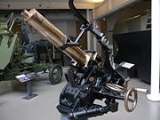
QF 1 pounder pom-pom
Encyclopedia
The QF 1 pounder, universally known as the pom-pom, was an early 37 mm British
autocannon
. It was used by several countries initially as an infantry gun and later as a light anti-aircraft gun. The name comes from the sound it makes when firing.
. Its longer range necessitated exploding projectiles to judge range, which in turn dictated a shell weight of at least 400 gram (0.88184904873951 lb), as that was the lightest exploding shell allowed under the St. Petersburg Declaration of 1868 and reaffirmed in the Hague Convention of 1899
.
Early versions were sold under the Maxim-Nordenfelt
label, whereas versions in British service (i.e. from 1900) were labelled Vickers, Sons and Maxim (VSM) as Vickers
had bought out Maxim-Nordenfelt in 1897. They are all effectively the same gun.
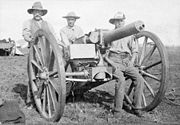
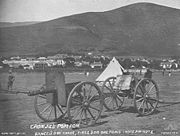 The British government initially rejected the gun but other countries bought it, including the South African Republic
The British government initially rejected the gun but other countries bought it, including the South African Republic
(Transvaal) government. In the Second Boer War
, the British found themselves being fired on with success by the Boers with their 37 mm Maxim-Nordenfelt
versions with ammunition made in Germany.
In response, Vickers-Maxim of Britain shipped either 57 or 50 guns out to the British Army
in South Africa, with the first three arriving in time for the Battle of Paardeberg
of February 1900. These early Mk I versions were mounted on typical field gun
type carriages.
mountings and deployed along London docks and on rooftops on key buildings in London, others on mobile motor lorries at key towns in the East and Southeast of England. 25 were employed in August 1914, and 50 in February 1916. The Mk II gun at the top of this page on Naval pedestal mounting was the first to open fire in defence of London during the war. However, the small shell was insufficient to damage the German Zeppelin
airships sufficiently to bring them down. The Ministry of Munitions noted in 1922: "The pom-poms were of very little value. There was no shrapnel available for them, and the shell provided for them would not burst on aeroplane fabric but fell back to earth as solid projectiles... were of no use except at a much lower elevation than a Zeppelin attacking London was likely to keep".
Nevertheless, Lieutenant O.F.J. Hogg of No. 2 AA Section in III Corps was the first anti-aircraft gunner to shoot down an aircraft, with 75 rounds on 23 September 1914 in France.
The British Army did not employ it as an infantry weapon in World War I, as its shell was considered too small for use against any objects or fortifications and British doctrine relied on shrapnel fired by QF 13 pounder and 18-pounder field guns as its primary medium range anti-personnel weapon.
The gun was tried with only limited success mounted on aircraft as the lighter 1-pounder Mk III, and was quickly replaced by the larger QF 1½ pounder and QF 2 pounder
naval guns as a light anti-aircraft gun.
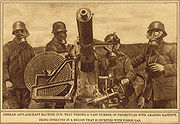 A version was produced in Germany for both Navy and Army.
A version was produced in Germany for both Navy and Army.
In World War I, it was used in Europe as an anti-aircraft gun as the Maxim Flak M14. Four guns were used mounted on field carriages in the German campaign in South West Africa in 1915, against South African forces.
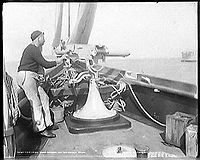 The U.S. Navy
The U.S. Navy
adopted the Maxim-Nordenfelt 37 mm 1 pounder as the 1-pounder Mark 6 before the 1898 Spanish–American War.
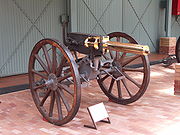
United Kingdom
The United Kingdom of Great Britain and Northern IrelandIn the United Kingdom and Dependencies, other languages have been officially recognised as legitimate autochthonous languages under the European Charter for Regional or Minority Languages...
autocannon
Autocannon
An autocannon or automatic cannon is a rapid-fire projectile weapon firing a shell as opposed to the bullet fired by a machine gun. Autocannons often have a larger caliber than a machine gun . Usually, autocannons are smaller than a field gun or other artillery, and are mechanically loaded for a...
. It was used by several countries initially as an infantry gun and later as a light anti-aircraft gun. The name comes from the sound it makes when firing.
History
Hiram Maxim originally designed the Pom-Pom in the late 1880s as an enlarged version of the Maxim machine gunMaxim gun
The Maxim gun was the first self-powered machine gun, invented by the American-born British inventor Sir Hiram Maxim in 1884. It has been called "the weapon most associated with [British] imperial conquest".-Functionality:...
. Its longer range necessitated exploding projectiles to judge range, which in turn dictated a shell weight of at least 400 gram (0.88184904873951 lb), as that was the lightest exploding shell allowed under the St. Petersburg Declaration of 1868 and reaffirmed in the Hague Convention of 1899
Hague Conventions (1899 and 1907)
The Hague Conventions were two international treaties negotiated at international peace conferences at The Hague in the Netherlands: The First Hague Conference in 1899 and the Second Hague Conference in 1907...
.
Early versions were sold under the Maxim-Nordenfelt
Maxim Nordenfelt Guns and Ammunition Company
The Maxim-Nordenfelt Guns and Ammunition Company was the result of a takeover by Hiram Maxim of Thorsten Nordenfelt's Nordenfelt Guns and Ammunition Company in 1888.-History:The company produced a range of light artillery, machine guns and ammunition....
label, whereas versions in British service (i.e. from 1900) were labelled Vickers, Sons and Maxim (VSM) as Vickers
Vickers
Vickers was a famous name in British engineering that existed through many companies from 1828 until 1999.-Early history:Vickers was formed in Sheffield as a steel foundry by the miller Edward Vickers and his father-in-law George Naylor in 1828. Naylor was a partner in the foundry Naylor &...
had bought out Maxim-Nordenfelt in 1897. They are all effectively the same gun.
Second Boer War


South African Republic
The South African Republic , often informally known as the Transvaal Republic, was an independent Boer-ruled country in Southern Africa during the second half of the 19th century. Not to be confused with the present-day Republic of South Africa, it occupied the area later known as the South African...
(Transvaal) government. In the Second Boer War
Second Boer War
The Second Boer War was fought from 11 October 1899 until 31 May 1902 between the British Empire and the Afrikaans-speaking Dutch settlers of two independent Boer republics, the South African Republic and the Orange Free State...
, the British found themselves being fired on with success by the Boers with their 37 mm Maxim-Nordenfelt
Maxim Nordenfelt Guns and Ammunition Company
The Maxim-Nordenfelt Guns and Ammunition Company was the result of a takeover by Hiram Maxim of Thorsten Nordenfelt's Nordenfelt Guns and Ammunition Company in 1888.-History:The company produced a range of light artillery, machine guns and ammunition....
versions with ammunition made in Germany.
In response, Vickers-Maxim of Britain shipped either 57 or 50 guns out to the British Army
British Army
The British Army is the land warfare branch of Her Majesty's Armed Forces in the United Kingdom. It came into being with the unification of the Kingdom of England and Scotland into the Kingdom of Great Britain in 1707. The new British Army incorporated Regiments that had already existed in England...
in South Africa, with the first three arriving in time for the Battle of Paardeberg
Battle of Paardeberg
The Battle of Paardeberg or Perdeberg was a major battle during the Second Anglo-Boer War. It was fought near Paardeberg Drift on the banks of the Modder River in the Orange Free State near Kimberley....
of February 1900. These early Mk I versions were mounted on typical field gun
Field gun
A field gun is an artillery piece. Originally the term referred to smaller guns that could accompany a field army on the march and when in combat could be moved about the battlefield in response to changing circumstances, as to opposed guns installed in a fort, or to siege cannon or mortars which...
type carriages.
World War I
In World War I, it was used as an early anti-aircraft gun in the home defence of Britain. It was adapted as the Mk I*** and Mk II on high-angle pedestalPedestal
Pedestal is a term generally applied to the support of a statue or a vase....
mountings and deployed along London docks and on rooftops on key buildings in London, others on mobile motor lorries at key towns in the East and Southeast of England. 25 were employed in August 1914, and 50 in February 1916. The Mk II gun at the top of this page on Naval pedestal mounting was the first to open fire in defence of London during the war. However, the small shell was insufficient to damage the German Zeppelin
Zeppelin
A Zeppelin is a type of rigid airship pioneered by the German Count Ferdinand von Zeppelin in the early 20th century. It was based on designs he had outlined in 1874 and detailed in 1893. His plans were reviewed by committee in 1894 and patented in the United States on 14 March 1899...
airships sufficiently to bring them down. The Ministry of Munitions noted in 1922: "The pom-poms were of very little value. There was no shrapnel available for them, and the shell provided for them would not burst on aeroplane fabric but fell back to earth as solid projectiles... were of no use except at a much lower elevation than a Zeppelin attacking London was likely to keep".
Nevertheless, Lieutenant O.F.J. Hogg of No. 2 AA Section in III Corps was the first anti-aircraft gunner to shoot down an aircraft, with 75 rounds on 23 September 1914 in France.
The British Army did not employ it as an infantry weapon in World War I, as its shell was considered too small for use against any objects or fortifications and British doctrine relied on shrapnel fired by QF 13 pounder and 18-pounder field guns as its primary medium range anti-personnel weapon.
The gun was tried with only limited success mounted on aircraft as the lighter 1-pounder Mk III, and was quickly replaced by the larger QF 1½ pounder and QF 2 pounder
QF 2 pounder naval gun
The 2-pounder gun, officially designated the QF 2-pounder and universally known as the pom-pom, was a 1.575 inch British autocannon, used famously as an anti-aircraft gun by the Royal Navy. The name came from the sound that the original models make when firing...
naval guns as a light anti-aircraft gun.
British Ammunition
The British are reported to have initially used some Common pointed shells (semi-armour piercing, with fuze in the shell base) in the Boer War, in addition to the standard Common shell. However, the common pointed shell proved unsatisfactory, with the base fuze frequently working loose and falling out during flight. In 1914, the cast-iron common shell and tracer were the only available rounds.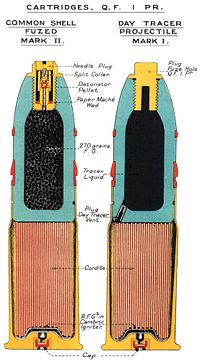 |
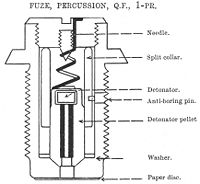 |
German service

In World War I, it was used in Europe as an anti-aircraft gun as the Maxim Flak M14. Four guns were used mounted on field carriages in the German campaign in South West Africa in 1915, against South African forces.
Belgian service
The Belgian Army used the gun on a high-angle field carriage mounting.United States service

United States Navy
The United States Navy is the naval warfare service branch of the United States Armed Forces and one of the seven uniformed services of the United States. The U.S. Navy is the largest in the world; its battle fleet tonnage is greater than that of the next 13 largest navies combined. The U.S...
adopted the Maxim-Nordenfelt 37 mm 1 pounder as the 1-pounder Mark 6 before the 1898 Spanish–American War.
Surviving examples

- A gun from 1903 at the Imperial War MuseumImperial War MuseumImperial War Museum is a British national museum organisation with branches at five locations in England, three of which are in London. The museum was founded during the First World War in 1917 and intended as a record of the war effort and sacrifice of Britain and her Empire...
London - Two German-manufactured 1903 guns used during World War IWorld War IWorld War I , which was predominantly called the World War or the Great War from its occurrence until 1939, and the First World War or World War I thereafter, was a major war centred in Europe that began on 28 July 1914 and lasted until 11 November 1918...
are on display at the South African National Museum of Military HistorySouth African National Museum of Military HistoryThe South African National War Museum in Johannesburg was officially opened by Prime Minister Jan Smuts on 29 August 1947 to preserve the history of South Africa's involvement in the Second World War. In 1975 the museum was renamed the South African National Museum of Military History and its...
, JohannesburgJohannesburgJohannesburg also known as Jozi, Jo'burg or Egoli, is the largest city in South Africa, by population. Johannesburg is the provincial capital of Gauteng, the wealthiest province in South Africa, having the largest economy of any metropolitan region in Sub-Saharan Africa...
. Nr. 542 and 543 from the Deutsche Waffen und Munitions Fabriken - A German-manufactured gun in the Wehrtechnische Studiensammlung Koblenz
- A gun in the Canadian War MuseumCanadian War MuseumThe Canadian War Museum is Canada’s national museum of military history. Located in Ottawa, Ontario, the museum covers all facets of Canada’s military past, from the first recorded instances of death by armed violence in Canadian history several thousand years ago to the country’s most recent...
. - A gun in the Museo Naval y Maritimo Valparaiso, Chile.
See also
- COW 37 mm gunCOW 37 mm gunThe COW 37 mm gun was a British automatic cannon that was developed as a heavy-calibre aircraft weapon.It was trialled in several installations and specified for the Westland C.O.W. Gun Fighter...
- List of anti-aircraft guns
- List of infantry guns
- British standard ordnance weights and measurementsBritish standard ordnance weights and measurementsThe British standard ordnance weights and measurements for the artillery were established by the Master General of Ordnance in 1764, and these were not altered until 1919 when the metric system was additionally introduced....
External links
- Anthony G Williams, 37MM AND 40MM GUNS IN BRITISH SERVICE

